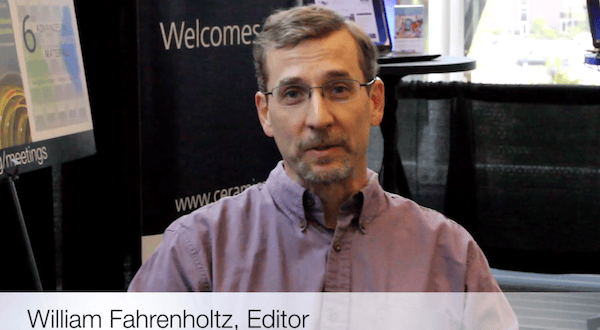
“The reports of my death have been greatly exaggerated.” — Mark Twain
Some prognosticators claim the book industry is dead. Not so. It has evolved in some interesting ways, though. For example, did you know that 63% of print book buyers make more than $50,000 annually, average 42 years of age, are likely to be women (60% vs. 40% men), and 61% of them have a college degree? Consumers like format choices—22% buy e-books, 27% buy hardcover, and 45% prefer paperback. (The balance are audio and “other.”)
Adult fiction titles—the largest category—comprise 42% of the units of books sold, but only bring in 29% of book revenue. The smallest-selling category—scientific, technical, and medical books—“rakes in” 9% of the revenue pie, while selling just 3% of units.
Obviously, technical books are more valuable, despite their small audience.
We here at ACerS know our audience is small, but we also know it is well-educated, smart, successful, and intellectually curious. Thus, we are always proud and excited to announce the release of new books published in conjunction with our publishing partner, Wiley.
A new book on ultra-high temperature ceramics (UHTC) is the first book to focus on this family of materials in more than 20 years. “Ultra-High Temperature Ceramics: Materials for Extreme Environment Applications,” edited by William G. Fahrenholtz, Eric J. Wuchina, William E. Lee, and Yanchun Zhou, grew out of a 2012 conference held in Hernstein, Austria on the subject. The editors invited a select number of presenters to contribute chapters to the book.
Fahrenholtz, Curator’s professor of ceramic engineering at Missouri S&T, explains in an email, “The aim was to present a broad cross-section of the current understanding along with some perspective related to ongoing needs. We wanted to avoid having the contributions be like journal articles, which narrowly focus on new insight from a limited number of experiments.” Fahrenholtz told us more in a video interview when he stopped by the ACerS member lounge at MS&T a few weeks ago.
UHTCs typically are borides, nitrides, and carbides of refractory metals, such as titanium, zirconium, hafnium, molybdenum, and tantalum. Applications include hypersonic vehicles and other extreme environments, such as nuclear reactor designs, nuclear fuel forms, high-speed cutting tools, rocket propulsion, molten metal contact, diffusion barriers in microelectronics, and concentrated solar power systems.
These materials melt at very high temperatures, in the neighborhood of 3,000˚C. How does one sinter such a refractory material? How are properties measured for service conditions that reach Mach 5 or 2,000˚C?
These compelling questions intrigue Fahrenholtz. “I find these compounds to be fascinating,” he simply says. “Even though the UHTC family contains a relatively small number of compounds, a large number of unanswered questions remain about the intrinsic properties of the materials and their behavior in the extreme environments…As we discover more about them, we seem to raise more questions than we answer, which provides continuing opportunities for basic research in the future.”
NASA Glenn Research Center scientist Narrotam Bansal and collaborator Jacques Lamon at Ecole Normale Supérieure Cachan (Paris, France) have edited a new volume on ceramic matrix composites, “Ceramic Matrix Composites: Materials, Modeling and Technology.” These materials, too, are used in challenging environments, albeit perhaps less extreme than UHTCs will experience. The book covers a lot of ground—carbide and oxide matrices, various reinforcement forms, composite structures, processing, applications, testing, and modeling all along the way. Increasingly, researchers think of materials as systems of materials. Composites are fundamental materials systems with much to offer.
Looking ahead to December, the ACerS-Wiley enterprise will release one more book, which the authors say is ideal as a graduate textbook—“Biosurfaces: A Materials Science and Engineering Perspective,” by Kantesh Balani, Vivek Verma, Arvind Agarwal, and Roger Narayan.
The book provides the framework necessary to start thinking about designing effective biomaterials. It delves into issues such as how materials interact with tissue, immunology, biocompatibility, and surfaces, surfaces, surfaces. The authors include a chapter on multiscale hierarchy in natural materials so that lessons from nature can be applied to fabricating new components when nature cannot. Processing and modeling chapters provide tools to convert materials knowledge into biomaterials. Finally, the authors close with a critical chapter, “Nanosafety, Nanosocietal and Nanoetihcal Issues.” This last is an essential conversation that materials professionals must not shirk.
Here are the new books, available in hardcover or e-book formats. (Sorry, no paperback options.)
 Ultra-High Temperature Ceramics: Materials for Extreme Environment Applications
Ultra-High Temperature Ceramics: Materials for Extreme Environment Applications
William G. Fahrenholtz, Eric J. Wuchina, William E. Lee, Yanchun Zhou (Editors)
November 2014 | 456 pages
Hardcover: US $179.95 | eBook: US$143.99
Ceramic Matrix Composites: Materials, Modeling and Technology
Narottam P. Bansal, Jacques Lamon
November 2014 | 712 pages
Hardcover: US $199.95 | eBook: US$159.99
 Biosurfaces: A Materials Science and Engineering Perspective
Biosurfaces: A Materials Science and Engineering Perspective
Kantesh Balani, Vivek Verma, Arvind Agarwal, Roger Narayan
December 2014 | 400 pages
Hardcover: US $149.95 (eBook coming soon)
Author
Eileen De Guire
Spotlight Categories
- Journal and Bulletin Updates
Related Posts
Volunteer spotlight: Hyunjun Kim
December 18, 2025
ACerS GOMD History – A Look Back in Time
December 10, 2025



